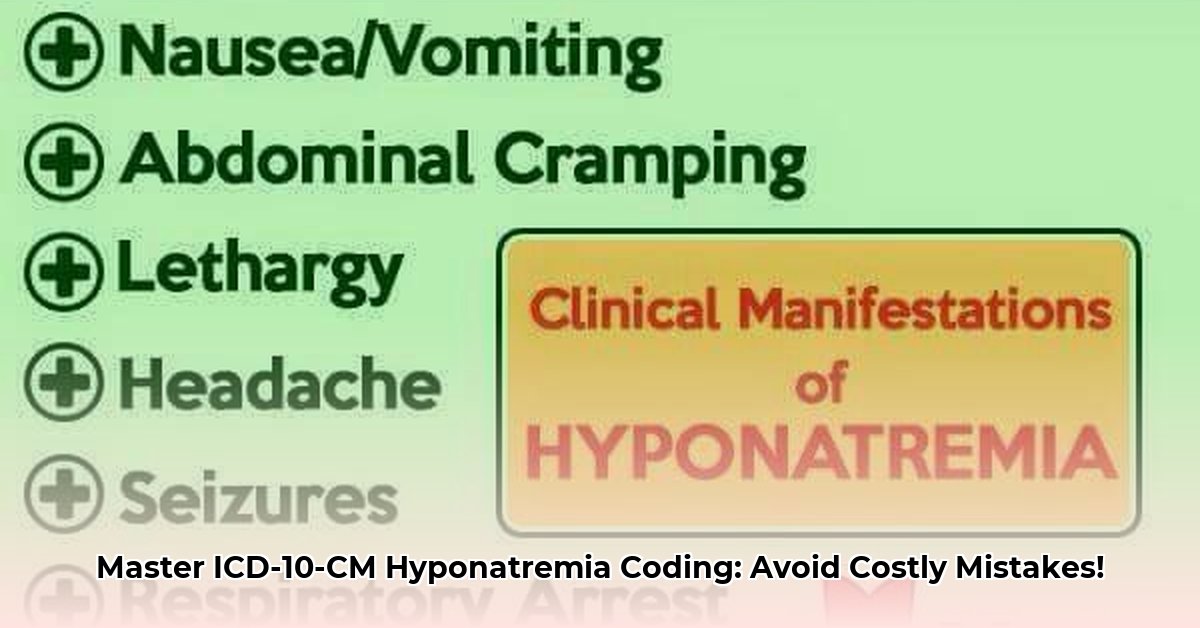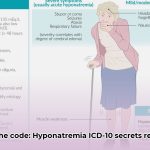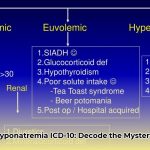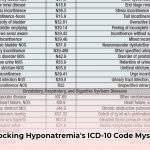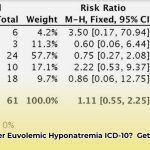Ever wondered about the secret code doctors use to describe low sodium in the blood (hyponatremia)? Getting the ICD-10-CM code right—specifically E87.1—is essential for accurate payments and patient records. For more detailed information on hyponatremia ICD-10 codes, check out this helpful resource: Hyponatremia ICD-10 Codes. This comprehensive guide clarifies the appropriate and inappropriate applications of this code, empowering you to confidently navigate medical billing related to hyponatremia and minimize costly errors.
ICD-10-CM Hyponatremia: Mastering the Code to Avoid Costly Mistakes
Medical billing is complex, and navigating codes like ICD-10-CM for hyponatremia adds another layer of intricacy. This guide provides a detailed roadmap for accurately coding hyponatremia, minimizing errors, and avoiding potential financial repercussions.
Understanding Hyponatremia, Hypo-osmolality and ICD-10-CM Code E87.1
Hyponatremia, characterized by low sodium levels in the blood (below 135 mEq/L), isn’t a disease in itself but rather a sign of an underlying issue affecting electrolyte balance. ICD-10-CM code E87.1, “Hypo-osmolality and hyponatremia,” serves as a general or “catch-all” code, particularly useful when the precise cause of low sodium remains undetermined after initial evaluation. Accurate diagnosis forms the cornerstone of correct coding and optimal patient care, ensuring the delivery of targeted and effective treatment strategies.
Decoding the Differences: Why Specificity Matters in Electrolyte Imbalance
The appropriate use of E87.1 demands careful consideration of underlying conditions. Numerous factors can contribute to hyponatremia, and many of these conditions have their own specific ICD-10-CM codes. Consequently, employing E87.1 when a more precise code exists constitutes a coding error, potentially leading to financial discrepancies and compromised data integrity.
| Condition | ICD-10-CM Code | Description |
|---|---|---|
| Syndrome of Inappropriate Antidiuretic Hormone (SIADH) | E22.2 | Your body produces excessive antidiuretic hormone (ADH), leading to fluid retention and diluted sodium levels, impacting fluid balance. |
| Diabetes Insipidus | E23.2 | Your body exhibits insufficient production or response to antidiuretic hormone (ADH), resulting in excessive urination and potential dehydration. |
| Neonatal Hyponatremia | P74.22 | Hyponatremia specifically occurring in newborns, demanding specialized diagnostic and treatment approaches. |
| Cerebral Salt Wasting | E24.4 | Hyponatremia stemming from neurological conditions that disrupt sodium reabsorption in the kidneys, affecting electrolyte balance. |
| Hyponatremia due to Drug-Induced | T36-T50 with 6th character 5 | Hyponatremia stems from side effects of various medications, such as diuretics, antidepressants, or certain pain relievers. |
For instance, in a patient diagnosed with hyponatremia directly attributable to SIADH, the utilization of E87.1 would be deemed inaccurate. Instead, E22.2 accurately reflects the underlying etiology, ensuring not only proper billing practices but also facilitating the development of an informed and targeted treatment plan.
Clinical Documentation: The Foundation for Accurate Coding Practices
Clinical documentation constitutes the bedrock of coding accuracy, serving as the vital link between physician observations, diagnostic findings, and the selected code employed for billing purposes. Comprehensive documentation should encompass the following essential elements:
- Serum Sodium Levels: Precise quantification of sodium concentration (mEq/L or mmol/L) obtained from blood tests, reflecting the severity of the electrolyte imbalance.
- Urine Osmolality: Evaluation of kidney function, specifically the kidney’s capacity to concentrate urine, providing insights into fluid balance regulation.
- Clinical Symptoms: Detailed description of patient-reported symptoms, including nausea, vomiting, headache, confusion, seizures, or muscle weakness, reflecting the clinical presentation and severity of hyponatremia.
- Underlying Medical Conditions: Identification of coexisting health conditions (e.g., heart failure, kidney disease, liver cirrhosis, SIADH, diabetes insipidus) that may contribute to or exacerbate hyponatremia, guiding treatment strategies.
- Medications: Document use of diuretics, antidepressants, and pain relievers.
- Fluid Balance: Note intravenous fluids and any fluid restriction.
Without comprehensive and well-articulated documentation, substantiating the selection of E87.1 becomes exceedingly challenging, significantly elevating the risk of coding errors and potential claim denials.
Navigating the Pitfalls: Avoiding Costly Coding Mistakes in Medical Care
Inaccurate coding of hyponatremia carries substantial repercussions, including the instigation of audits and investigations, imposition of financial penalties, and potential violations of patient privacy regulations (e.g., HIPAA). To mitigate these risks and ensure coding integrity, adherence to the following best practices is paramount:
- Stay Informed: Remain abreast of the latest revisions and updates to ICD-10-CM coding guidelines, coding updates, and industry best practices through continuing education, professional development, and consultation with coding experts.
- Utilize Resources: Leverage reputable coding resources, such as coding manuals, online databases, and professional organizations, for guidance on code selection, coding conventions, and documentation requirements; seek clarification from coding experts or consultants when uncertainties arise.
- Teamwork Makes the Dream Work: Foster collaborative partnerships between clinicians, coding professionals, and billing staff to promote seamless communication, shared understanding, and accurate translation of clinical information into coded data; encourage open dialogue, mutual respect, and collaborative problem-solving to enhance coding accuracy and compliance.
A Team Effort: Ensuring Accurate Coding for Everyone in Healthcare
Achieving accurate hyponatremia coding necessitates a collaborative approach involving clinicians, coding specialists, and billing personnel. Clinicians play a pivotal role in providing detailed medical information, while coders leverage their expertise to assign the most appropriate codes based on the available documentation. This synergistic collaboration ensures coding accuracy, minimizes the risk of miscoding, and promotes optimal patient care and accurate billing practices, resulting in a mutually beneficial outcome for all stakeholders.
How to Accurately Code Hyponatremia Using ICD-10 E87.1
Key Takeaways:
- Accurate coding of hyponatremia is contingent upon precise clinical documentation, serving as the foundation for effective medical billing and reimbursement.
- ICD-10 code E87.1 serves as the primary code for hyponatremia, supplemented by additional codes that capture underlying causes, associated symptoms, and comorbid conditions to provide a comprehensive representation of the patient’s clinical presentation.
- Inconsistent or incomplete documentation heightens the risk of claim denials, coding audits, and regulatory scrutiny, underscoring the importance of thorough and accurate documentation practices.
- Clinicians and coders require ongoing training, education, and access to updated coding guidelines to ensure proficiency in coding nuances and compliance with evolving regulatory requirements.
- Data analytics tools and techniques can be employed to identify coding deficiencies, track coding patterns, and improve reimbursement strategies, fostering continuous quality improvement in coding accuracy and efficiency.
Understanding Hyponatremia and ICD-10-CM Code E87.1
Hyponatremia, characterized by low sodium levels in the blood (typically below 135 mmol/L), can manifest with a spectrum of symptoms, ranging from mild and nonspecific (e.g., nausea, headache) to severe and life-threatening (e.g., seizures, coma), depending on the severity and rapidity of onset. E87.1, “Hypo-osmolality and hyponatremia,” serves as the initial coding point for hyponatremia and related conditions, providing a broad classification for cases where the underlying etiology is not yet fully elucidated. Consider this code as the starting point. More specific codes can be added to provide additional detail in the coding process.
Differentiating E87.1 from Other Codes for Specific Conditions
E87.1 should not be used as a universal solution for all cases of hyponatremia. Because many conditions can precipitate hyponatremia, such as SIADH (E22.2) or diabetes insipidus (E23.2). Each condition warrants specific coding, reflecting the most accurate and precise diagnosis. Neglecting to utilize the correct additional code may lead to inaccurate billing, potentially resulting in missed reimbursements and compromised data integrity. Here’s a simplified comparison of commonly encountered scenarios:
| Condition | ICD-10 Code | Description |
|---|---|---|
| Hyponatremia (general) | E87.1 | Low serum sodium, unspecified etiology in the diagnosis, serving as a provisional code until further diagnostic workup is completed. |
| SIADH | E22.2 | Syndrome of inappropriate antidiuretic hormone secretion, characterized by excessive ADH release and subsequent fluid retention, affecting fluid balance. |
| Diabetes Insipidus | E23.2 | Deficiency of antidiuretic hormone (ADH) or resistance to its effects, |
- Wellness Fair Ideas for Work to Boost Employee Wellbeing - December 15, 2025
- Affordable Employee Wellness Fair Ideas for Any Budget - December 14, 2025
- Employee Wellness Programs Strategically Benefit Employee Health And Retention - December 13, 2025
